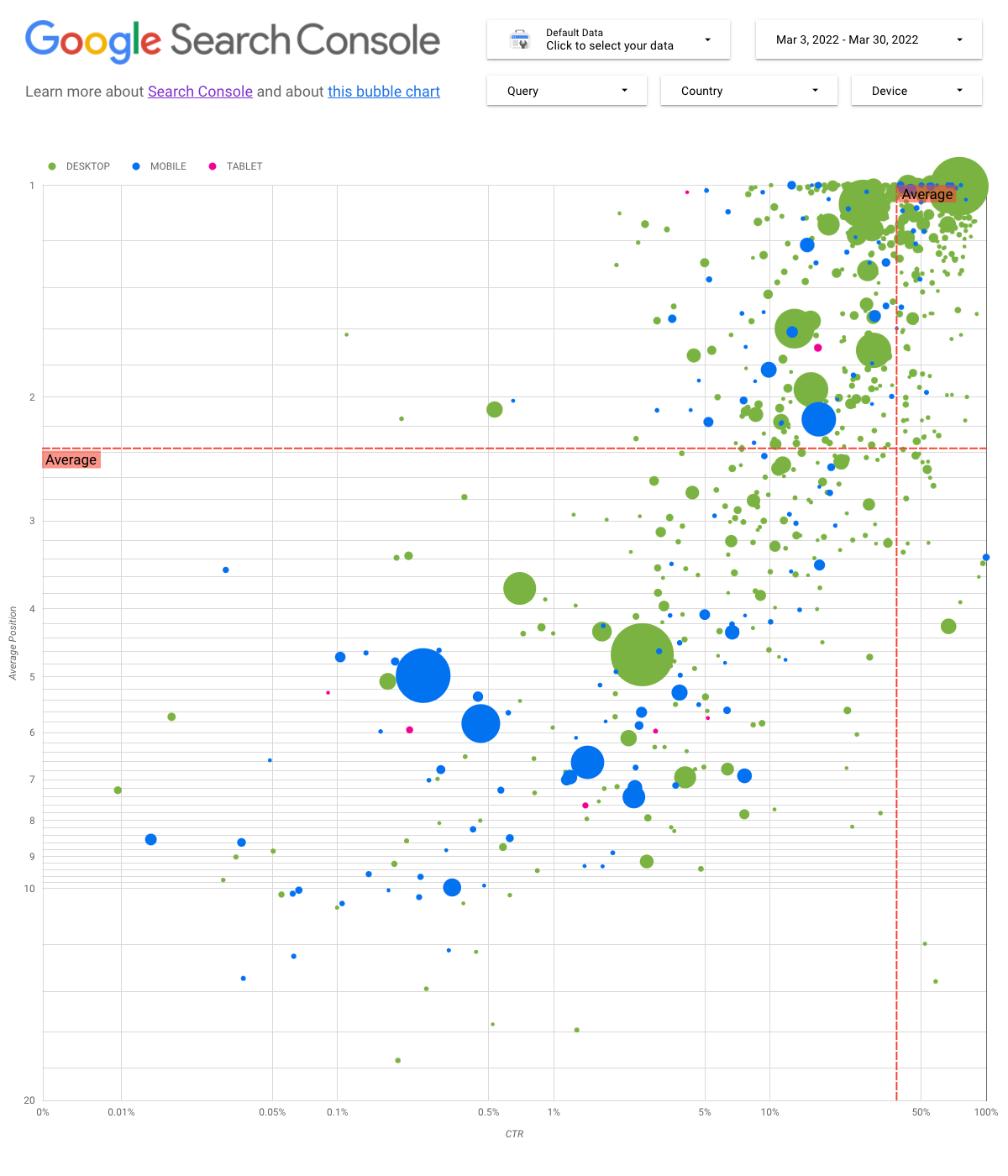วันพุธที่ 6 เมษายน 2022
การวิเคราะห์ข้อมูลประสิทธิภาพใน Search นั้นเป็นเรื่องที่ท้าทาย แต่จะยิ่งท้าทายขึ้นเมื่อคุณมีคำค้นหาเฉพาะเจาะจงจำนวนมากซึ่งมองเห็นภาพและเข้าใจได้ยาก ในโพสต์นี้ เราเผยเคล็ดลับที่จะช่วยให้คุณค้นพบโอกาสในการเพิ่มประสิทธิภาพใน Google Search ของเว็บไซต์
หากคุณยังไม่ได้อ่านโพสต์ล่าสุดเรื่องการเชื่อมต่อ Search Console กับ Data Studio และการตรวจสอบการเข้าชมจาก Search ด้วย Data Studio ให้ลองอ่านเพื่อทำความเข้าใจถึงสิ่งที่คุณสามารถทำโดยใช้ Search Console ใน Data Studio
วันนี้เราจะพูดถึงแผนภูมิฟองอากาศ ซึ่งช่วยให้คุณเข้าใจว่าคำค้นหาใดทำงานได้ดีสำหรับเว็บไซต์และคำค้นหาใดควรปรับปรุง ก่อนอื่นเราจะอธิบายองค์ประกอบหลักในแผนภูมิ โดยพูดถึงการตั้งค่าที่เจาะจงและอิทธิพลที่มีต่อข้อมูล จากนั้นก็จะแนะนำสิ่งที่ควรมองหาเมื่อวิเคราะห์ข้อมูล
เริ่มจากข่าวดี นั่นคือ คุณไม่จำเป็นต้องสร้างแผนภูมิใหม่ตั้งแต่ต้น ให้ใช้เทมเพลตนี้ เชื่อมต่อข้อมูล และปรับแต่งการตั้งค่าที่ต้องการ
มาเริ่มกันเลย...

การทำความเข้าใจแผนภูมิ
แผนภูมิฟองอากาศเป็นการแสดงภาพที่ยอดเยี่ยมเมื่อคุณมีเมตริกและมิติข้อมูลหลายรายการ เนื่องจากช่วยให้ดูความสัมพันธ์และรูปแบบในข้อมูลได้อย่างมีประสิทธิภาพมากขึ้น ในตัวอย่างที่แสดงอยู่นี้ คุณจะเห็นแอตทริบิวต์การเข้าชม (อัตราการคลิกผ่าน (CTR), อันดับเฉลี่ย) และปริมาณ (การคลิกทั้งหมด) ของมิติข้อมูลต่างๆ (คำค้นหา อุปกรณ์) พร้อมกัน
เราจะอธิบายองค์ประกอบบางอย่างของแผนภูมิเพื่อชี้แจงสิ่งที่แผนภูมิแสดงและไม่ได้แสดง
แหล่งข้อมูล
สำหรับแผนภูมินี้ เราใช้ตารางการแสดงผลในเว็บไซต์ที่ใช้งานได้ผ่านแหล่งข้อมูล Search Console ซึ่งมีข้อมูลประสิทธิภาพใน Search ที่รวบรวมไว้โดยแบ่งตามเว็บไซต์และคำค้นหา
ตัวกรองและการควบคุมข้อมูล
เราได้เพิ่มตัวเลือกการปรับแต่ง 5 รายการต่อไปนี้ในแผนภูมิเพื่อให้คุณควบคุมข้อมูลได้อย่างมีประสิทธิภาพ
- การควบคุมข้อมูล: เลือกพร็อพเพอร์ตี้ Search Console ที่ต้องการวิเคราะห์
- ช่วงวันที่: เลือกช่วงวันที่ที่ต้องการดูในรายงาน คุณจะเห็นข้อมูลในช่วง 28 วันที่ผ่านมาโดยค่าเริ่มต้น
- คำค้นหา: รวมหรือยกเว้นคำค้นหาที่ต้องการมุ่งเน้น คุณสามารถใช้นิพจน์ทั่วไปได้เช่นเดียวกับที่ใช้ใน Search Console
- ประเทศ: รวมหรือยกเว้นประเทศ
- อุปกรณ์: รวมหรือยกเว้นหมวดหมู่อุปกรณ์
แกน
แกนในแผนภูมิคืออันดับเฉลี่ย (แกน Y) และ CTR ของเว็บไซต์ (แกน X) แต่เราได้ทำการเปลี่ยนที่สำคัญ 3 อย่างต่อไปนี้เพื่อให้แผนภูมิมีข้อมูลเชิงลึกมากขึ้น
- กลับทิศทางของแกน Y: เนื่องจากแกน Y แสดงอันดับเฉลี่ย การกลับทิศทางจึงทำให้เลข 1 อยู่ด้านบน สำหรับแผนภูมิธุรกิจส่วนใหญ่ ตำแหน่งที่ดีที่สุดจะอยู่ในมุมขวาบน การกลับทิศทางของแกน Y จึงทำให้ดูได้ง่ายขึ้นเมื่อใช้แสดงอันดับเฉลี่ย
- สเกล Log: สเกลลอการิทึมคือ "วิธีแสดงข้อมูลตัวเลขซึ่งมีช่วงค่ากว้างมากในลักษณะที่กระชับ (...) การเลื่อนหน่วยระยะทางไปตามสเกลหมายถึงมีการคูณตัวเลขนั้นด้วย 10" การใช้สเกล Log สำหรับทั้ง 2 แกนช่วยให้คุณเข้าใจคำค้นหาซึ่งอยู่ที่ปลายสุดของแผนภูมิ (CTR หรืออันดับเฉลี่ยที่ต่ำมาก หรือทั้งสองอย่าง) ได้ดีขึ้น
- เส้นอ้างอิง: เส้นอ้างอิงมีประโยชน์อย่างยิ่งในการไฮไลต์ค่าที่สูงหรือต่ำกว่าเกณฑ์หนึ่งๆ การดูค่าเฉลี่ย ค่ามัธยฐาน หรือเปอร์เซ็นไทล์หนึ่งๆ จะช่วยให้เห็นค่าที่เบี่ยงเบนไปจากรูปแบบได้ชัดเจน
ฟองอากาศ
ฟองอากาศแต่ละลูกในแผนภูมิแสดงคำค้นหา 1 รายการ เราใช้คุณสมบัติของรูปแบบ 2 รายการต่อไปนี้เพื่อให้แผนภูมิมีประโยชน์มากขึ้น
- ขนาด: การแสดงจำนวนคลิกโดยใช้ขนาดฟองอากาศช่วยให้คุณเห็นได้อย่างรวดเร็วว่าคำค้นหาใดกระตุ้นการเข้าชมจำนวนมาก ยิ่งฟองอากาศมีขนาดใหญ่ก็แสดงว่าคำค้นหาสร้างการเข้าชมได้มาก
- สี: การแสดงหมวดหมู่อุปกรณ์โดยใช้สีฟองอากาศช่วยให้คุณทราบความแตกต่างระหว่างประสิทธิภาพใน Search บนอุปกรณ์เคลื่อนที่กับเดสก์ท็อป คุณใช้สีแทนมิติข้อมูลใดก็ได้ แต่เมื่อมีหลายค่ามากขึ้น ก็จะทำให้เห็นรูปแบบไม่ชัดเจน
การวิเคราะห์ข้อมูล
เป้าหมายของการแสดงภาพนี้คือช่วยให้เห็นโอกาสในการเพิ่มประสิทธิภาพการค้นหา แผนภูมิประเภทนี้แสดงประสิทธิภาพของคำค้นหา โดยแกน Y แสดงอันดับเฉลี่ย แกน X แสดง CTR ขนาดฟองอากาศแสดงจำนวนการคลิกทั้งหมด และสีฟองอากาศแสดงหมวดหมู่อุปกรณ์
เส้นอ้างอิงสีแดงแสดงค่าเฉลี่ยของแต่ละแกน ซึ่งแยกแผนภูมิออกเป็น 4 ส่วนที่แทนประสิทธิภาพ 4 ประเภทของคำค้นหา ส่วนเหล่านี้ในแผนภูมิของคุณอาจดูแตกต่างจากที่แชร์ในโพสต์นี้ เนื่องจากจะขึ้นอยู่กับลักษณะการกระจายการค้นหาของเว็บไซต์

โดยทั่วไป แผนภูมิจะแสดงกลุ่ม 4 กลุ่มที่คุณสามารถวิเคราะห์เพื่อช่วยให้ตัดสินใจได้ว่าควรมุ่งเน้นเรื่องใดเมื่อเพิ่มประสิทธิภาพของคำค้นหา
- อันดับสูงสุด, CTR สูง: คุณไม่จำเป็นต้องดำเนินการใดมากนักเนื่องจากประสิทธิภาพดีมากอยู่แล้ว
- อันดับต่ำ, CTR สูง: ดูเหมือนว่าคำค้นหาเกี่ยวข้องกับผู้ใช้ คำค้นหาเหล่านี้ได้รับ CTR สูงแม้ว่าจะอยู่ในอันดับต่ำกว่าคำค้นหาโดยเฉลี่ยในเว็บไซต์ และอาจแสดงถึงการมีส่วนร่วมที่สำคัญหากอันดับสูงขึ้น ดังนั้นให้เน้นเพิ่มประสิทธิภาพคำค้นหาเหล่านี้
- อันดับต่ำ, CTR ต่ำ: เมื่อดูคำค้นหาที่มี CTR ต่ำ (หัวข้อนี้ย่อยและหัวข้อย่อยถัดไป) คุณควรดูที่ขนาดของฟองอากาศเพื่อให้ทราบว่าคำค้นหาใดมี CTR ต่ำแต่ยังคงกระตุ้นการเข้าชมที่สำคัญอยู่ แม้ว่าคำค้นหาในส่วนนี้อาจดูเหมือนจะไม่คุ้มกับความพยายามเพิ่มประสิทธิภาพ แต่ก็แบ่งออกได้เป็น 2 กลุ่มหลักๆ ได้แก่
- คำค้นหาที่เกี่ยวข้อง: หากคำค้นหานี้สำคัญกับคุณ การปรากฏใน Search อยู่แล้วเป็นจุดเริ่มต้นที่ดี จัดลําดับความสำคัญของคำค้นหาเหล่านี้ก่อนคำค้นหาที่ไม่ปรากฏในผลการค้นหาเลย เนื่องจากจะเพิ่มประสิทธิภาพได้ง่ายกว่า
- การค้นหาที่ไม่เกี่ยวข้อง: หากคำค้นหาไม่เกี่ยวข้องกับเว็บไซต์ ก็อาจเป็นโอกาสที่ดีที่คุณจะปรับเนื้อหาให้มุ่งเน้นคำค้นหาที่จะสร้างการเข้าชมที่เกี่ยวข้อง
- อันดับสูงสุด, CTR ต่ำ: คำค้นหานี้อาจมี CTR ต่ำด้วยเหตุผลหลายประการ คุณควรตรวจสอบฟองอากาศที่ใหญ่ที่สุดเพื่อหาสัญญาณต่อไปนี้
- คู่แข่งอาจมีมาร์กอัป Structured Data ซึ่งแสดงพร้อมกับผลการค้นหาที่เป็นริชมีเดีย ซึ่งอาจดึงดูดให้ผู้ใช้คลิกผลการค้นหานั้นแทนที่จะเป็นผลการค้นหาของคุณ ลองเปิดใช้ฟีเจอร์ผลการค้นหาของ Search ในเว็บไซต์ของคุณ
- คุณอาจได้เพิ่มประสิทธิภาพหรือมีการจัดอันดับ "โดยไม่ตั้งใจ" สำหรับคำค้นหาที่ผู้ใช้ไม่สนใจซึ่งเกี่ยวข้องกับเว็บไซต์ของคุณ
- ผู้ใช้อาจพบข้อมูลที่ต้องการแล้ว เช่น เวลาทำการ ที่อยู่ หรือหมายเลขโทรศัพท์ของบริษัท
การเพิ่มประสิทธิภาพเว็บไซต์
เมื่อพบคำค้นหาที่คุ้มค่ากับเวลาและความพยายามแล้ว อย่าลืมเพิ่มประสิทธิภาพโดยศึกษาจากคู่มือ SEO สำหรับมือใหม่ มาดูเคล็ดลับบางส่วนกัน
- ตรวจสอบว่าองค์ประกอบ
title, แท็กmetaคำอธิบาย และแอตทริบิวต์altนั้นสื่อความหมาย มีความเจาะจง และถูกต้อง - ใช้องค์ประกอบส่วนหัวเพื่อเน้นข้อความสำคัญและช่วยให้เนื้อหามีโครงสร้างตามลำดับชั้น เพื่อให้ผู้ใช้และเครื่องมือค้นหาไปยังส่วนต่างๆ ในเอกสารได้ง่ายขึ้น
- เพิ่มมาร์กอัป Structured Data เพื่ออธิบายเนื้อหาให้เครื่องมือค้นหาเข้าใจและมีสิทธิ์แสดงเนื้อหาในลักษณะที่เป็นประโยชน์ (และสะดุดตา) ในผลการค้นหา
- ลองนึกถึงคำต่างๆ ที่ผู้ใช้อาจใช้ค้นหาเนื้อหาของคุณ ขอแนะนำให้ใช้เครื่องมือวางแผนคีย์เวิร์ดของ Google Ads เพื่อช่วยค้นหาคีย์เวิร์ดรูปแบบใหม่ๆ และดูปริมาณการค้นหาโดยประมาณของคีย์เวิร์ดแต่ละรายการ คุณยังใช้ Google เทรนด์เพื่อหาไอเดียจากหัวข้อที่กําลังเป็นที่นิยมและคำค้นหาที่เกี่ยวข้องกับเว็บไซต์ของคุณได้อีกด้วย
ความคิดเห็น
และเช่นเคย หากมีข้อสงสัยใดๆ โปรดแจ้งให้เราทราบผ่านชุมชน Google Search Central หรือชุมชน Data Studio นอกจากนี้ หากคุณใช้ Twitter อย่าลืมติดตามเรา เพราะเราจะแจ้งให้ทราบเมื่อมีโพสต์ใหม่ๆ ผ่านช่องทางนี้
